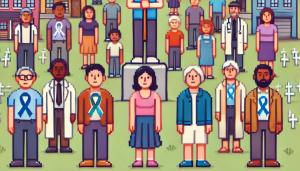
Best Public Health Tools for Local Government:
A Non-Partisan Guide to Data, Action, and Impact
In cities, towns, and counties across the U.S., public health decisions are made every day that shape the well-being of communities. Whether you’re trying to lower asthma rates in a city neighborhood or improve maternal health outcomes in a rural area, the challenge is the same: you need accurate data, effective planning tools, and a shared language to guide action.
This guide highlights the best public health tools available to local governments in the U.S., regardless of their political affiliation or population size. These tools, which include interactive dashboards and community planning frameworks, are designed to assist policymakers, public health officials, and civic leaders in making smarter, more transparent, and equitable decisions.
8/10/25 Note: I’m going to keep this post semi-updated by adding tools as I think of them or come across them.
Why Local Public Health Tools Matter
Effective public health policy starts with evidence. Tools that help local leaders visualize trends, track outcomes, and evaluate interventions are essential for planning, budgeting, and building trust. Importantly, the tools featured here are non-partisan and publicly available, allowing communities of all political leanings to benefit.
We’re not just listing digital dashboards. This guide includes both online tools and non-digital planning frameworks that support strategic public health work at the local level. All are U.S.-based and grounded in research or best practice.
Leading Digital Tools for Local Public Health
County Health Rankings & Roadmaps
Developed by the University of Wisconsin and the Robert Wood Johnson Foundation, County Health Rankings offers an annual snapshot of more than 3,000 U.S. counties. It includes measures like smoking, high school graduation, obesity, and air pollution. What makes it especially useful is the built-in “What Works for Health” library, which helps users translate data into action.
Policymakers use these rankings to prioritize local issues, apply for grants, and communicate with residents. Because the methodology is public and consistent across all counties, it’s a trusted resource regardless of political context.
CDC PLACES
The CDC’s PLACES tool provides small-area estimates for 29 chronic disease indicators, such as diabetes, depression, and obesity. You can view data down to the census tract or ZIP code, allowing for precise targeting of resources. It’s especially useful for communities that don’t have their own epidemiology staff or GIS capacity.
City Health Dashboard
The City Health Dashboard, created by NYU Grossman School of Medicine with support from the Robert Wood Johnson Foundation, provides up-to-date health data for over 1,200 U.S. cities. Launched in 2018, it offers more than 45 measures—from life expectancy to park access—to help communities and leaders improve health and equity. The tool continues to expand with new data, visualizations, and features to make local health insights easier to access and us.
Social Vulnerability Index (SVI)
Because of current federal policies, we had to dig a little for this one. Created by the CDC and ATSDR, the SVI ranks census tracts and counties based on 15 social factors, including poverty, lack of vehicle access, and crowded housing. Emergency planners and health departments use SVI to identify vulnerable populations—critical during disasters, pandemics, or heat waves.
Community Commons
Community Commons is a data-rich platform that combines social, environmental, and health datasets into interactive maps and tools. It’s ideal for community coalitions and public meetings where visual storytelling is key.
Community Toolbox
One of my favs, the Community Tool Box is a free online resource with over 300 modules and thousands of tools to help people improve community health, drive social change, and promote equity. Available in multiple languages and used in over 230 countries, it offers practical guidance on topics like assessment, planning, intervention, and advocacy. Developed by the University of Kansas and partners since 1994, its mission is to connect people, ideas, and resources to create healthier, more just communities worldwide.
NACCHO Toolbox
If you’re part of a local health department, the NACCHO Toolbox is worth bookmarking. It’s a curated collection of planning templates, training materials, and policy models. From emergency drills to community engagement guides, the Toolbox is designed to strengthen local capacity.
One CDC Data Platform & DMI
The CDC’s Data Modernization Initiative is building tools to standardize and share data across agencies. While many features are still rolling out, this platform aims to support outbreak tracking, lab reporting, and surveillance—all in near-real-time.n.
Non-Digital Frameworks and Models That Work
Getting to Outcomes
Getting to Outcomes (GTO) is a proven framework that helps communities and organizations plan, implement, and evaluate programs more effectively. It provides a step-by-step approach—from identifying needs to improving results—so users can make informed decisions and maximize impact. Developed by RAND and partners, GTO is widely used in public health, education, and social services to ensure programs are both effective and sustainable.
MAPP (Mobilizing for Action Through Planning & Partnerships)
MAPP is a six-phase framework designed by NACCHO and the CDC to guide community health improvement. It brings together cross-sector stakeholders to assess needs, prioritize issues, and create measurable plans. MAPP 2.0, updated in 2023, places greater emphasis on equity and community voice.
Local governments can use MAPP to structure a participatory planning process, often in conjunction with public health accreditation efforts.
PHAB Accreditation Standards
The Public Health Accreditation Board (PHAB) offers a voluntary process to ensure local health departments are meeting national standards. Version 2022 of the PHAB standards emphasizes equity, systems thinking, and performance improvement. Many of the digital tools above—like PLACES and SVI—can help meet accreditation requirements.
Health in All Policies (HiAP)
This is not a tool but a strategy: HiAP encourages governments to consider health outcomes in all policy areas—transportation, housing, education, and more. The County Health Rankings site offers a guide on implementing HiAP in state and local contexts. It’s an ideal approach for communities looking to integrate health goals across departments without expanding budgetsCommunity Health Improvement Plans (CHIPs)
A CHIP is the output of a structured planning process like MAPP. It sets multi-year health priorities with measurable goals. For example, a CHIP might include reducing opioid overdoses by 20% over three years. Because it’s community-driven, it helps align efforts across nonprofits, schools, hospitals, and local government.
How to Evaluate and Choose the Right Tools
Choosing the right tools depends on your local context. Here are a few criteria to guide decision-making:
- Geographic precision: Do you need county-level or neighborhood-level data?
- Equity insight: Can the tool disaggregate data by race, age, or income?
- Actionability: Does it provide solutions or just describe problems?
- Transparency: Are data sources and methods clearly explained?
- Ease of use: Can your team use it without a data scientist on staff?
Most communities benefit from combining tools—for example, using County Health Rankings to identify issues, PLACES for neighborhood-level data, and MAPP to guide planning.
A Step-by-Step Approach for Implementation
- Assess Needs: Review your community’s major health challenges using tools like County Health Rankings and SVI.
- Engage Stakeholders: Use the MAPP framework to involve diverse voices from health, education, housing, and community organizations.
- Select Tools: Choose 2–3 tools that match your top priorities, ensuring they offer both data and implementation guidance.
- Develop a CHIP: Use your data to set realistic, measurable goals. Ensure goals are tied to known evidence-based interventions.
- Monitor and Adapt: Use tools like PLACES and Community Commons to track progress, update the public, and refine strategies over time.
Real-World Example: Cuyahoga County, OH
Cuyahoga County used County Health Rankings to identify disparities in life expectancy between neighborhoods. Local officials then pulled in PLACES data to target asthma and heart disease hotspots. By engaging community groups using MAPP, they developed a CHIP focused on healthy housing, mental health, and economic mobility. This combination of digital tools and participatory frameworks helped align dozens of partners around shared goals and moved the needle on measurable outcomes.
Final Thoughts
Public health tools don’t have to be partisan. They can be practical, evidence-based, and accessible to communities of all types. By integrating dashboards, planning models, and frameworks like MAPP or HiAP, local governments can act with clarity and confidence.
Whether you’re launching a new initiative or updating a community health plan, these tools offer a strong foundation. The most successful communities aren’t those with the most data—they’re the ones who know how to use it.
Looking for support implementing these tools in your community? Contact us to explore PubTrawlr’s customizable dashboards, AI-powered grant discovery tools (coming soon!), and content tailored for local governments.



